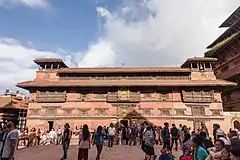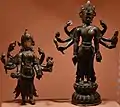पाटन संग्रहालय | |
    Clockwise from top: Façade of the museum, Golden window, Garden of the royal palace, Golden gate | |
| Established | 1982 |
|---|---|
| Location | Patan Durbar Square, Lalitpur, Nepal |
| Coordinates | 27°40′23″N 85°19′32″E / 27.6730952°N 85.3256380°E |
| Type | History museum |
| Visitors | 175,851 (2020) |
| Director | Damodar Gautam |
| Owner | Ministry of Culture,Tourism and Civil Aviation |
| Website | Official website |
The Patan Museum (Nepali: पाटन संग्रहालय) is a museum located in Patan, Lalitpur, Nepal.[1] The museum falls under the UNESCO's World Heritage Sites.[2] The Patan Museum was inaugurated in 1997 by Late King Birendra Bir Bikram Shah.[3] The Patan Museum displays the traditional sacred arts of Nepal in an illustrious architectural setting. Its home is an old residential court of Patan Durbar, one of the royal palaces of former Malla Kings of the Kathmandu Valley. The royal palace was built in 1734, on the site of a Buddhist monastery.[4] The museum quadrangle is known as Keshav Narayan Chowk.[5]
Present
Patan Durbar Square was heavily damaged by the earthquake in April 2015.[6]
Former International Artists in Residence include Nancy Condon, Jessica Melville-Brown, and Joy Lynn Davis.[7]
The current chairman of the Board of Directors is Kedar Bahadur Adhikari, from the Ministry of Culture, Tourism and Civil Aviation, Singh Durbar, Kathmandu.[8]
The entrance fees are 1000 Nepalese rupees for foreign visitors, 250 for SAARC visitors, 30 for Nepali visitors, and 15 for Nepalese students (with identification).[9]
Collection




The Patan Museum's mission is "the interpretation of Sacred Art, Culture and Iconography of Hinduism and Buddhism through preservation and exhibition."[10]
The museum's exhibits cover a long span of Nepal's cultural history. It has over 1,100 artifacts, about 200 of which are on permanent display.[11]
Most of the objects are cast bronzes (mostly sculptures of Hindu and Buddhist deities)[12] and gilt copper repoussé work, traditional crafts for which Patan is famous.[13]
Gallery
 Indra, a Vedic God in Hinduism. Copper repoussé, gilt with semi-precious stones, 13th-14th century, in the Patan Museum.
Indra, a Vedic God in Hinduism. Copper repoussé, gilt with semi-precious stones, 13th-14th century, in the Patan Museum. Lakshmi-Narayan Statue, 14th century
Lakshmi-Narayan Statue, 14th century
 Dīpankara Buddha, Nepal, 17th-18th century
Dīpankara Buddha, Nepal, 17th-18th century.JPG.webp) Four faced Shivalinga
Four faced Shivalinga
 Green Tara, Tibet, 17th century
Green Tara, Tibet, 17th century White Tara, Tibet, 17th-18th century
White Tara, Tibet, 17th-18th century A depiction of typical small chaityas found in Nepal.
A depiction of typical small chaityas found in Nepal.
 Amoghasiddhi, Tibet, 17th-18th century
Amoghasiddhi, Tibet, 17th-18th century Petal of Lotus with Vajrapani, Northern India, 12th-13th century
Petal of Lotus with Vajrapani, Northern India, 12th-13th century A model of the Great Chaitya of Boudhanath
A model of the Great Chaitya of Boudhanath
 Sketch depicting nepalese wood carving
Sketch depicting nepalese wood carving Sketch depicting nepalese style of window with carvings
Sketch depicting nepalese style of window with carvings Carving of religious deity on wooden pillar
Carving of religious deity on wooden pillar Another carving of religious deity on wooden pillar
Another carving of religious deity on wooden pillar A nepalese wooden window with carvings
A nepalese wooden window with carvings 87 figures and items related to buddhism
87 figures and items related to buddhism Sketch of wooden window with carvings
Sketch of wooden window with carvings
See also
Notes
- ↑ Museums and art galleries of Nepal (Archived August 19, 2012, at the Wayback Machine)
- ↑ "Patan Museum". Artmandu. Archived from the original on 9 April 2014. Retrieved 18 July 2013.
- ↑ "Welcome to Patan Museum". www.patanmuseum.gov.np. Retrieved 2020-03-06.
- ↑ "Welcome to Patan Museum". www.patanmuseum.gov.np. Retrieved 2020-03-06.
- ↑ "Welcome to Patan Museum". www.patanmuseum.gov.np. Retrieved 2020-03-06.
- ↑ Nair, Nithya (2015-04-25). "Earthquake in Nepal: Patan Durbar Square shattered completely". India News, Breaking News, Entertainment News | India.com. Retrieved 2020-03-06.
- ↑ "Welcome to Patan Museum". www.patanmuseum.gov.np. Retrieved 2020-03-06.
- ↑ "Welcome to Patan Museum". www.patanmuseum.gov.np. Retrieved 2020-03-06.
- ↑ "Welcome to Patan Museum". www.patanmuseum.gov.np. Retrieved 2020-03-06.
- ↑ "Welcome to Patan Museum". www.patanmuseum.gov.np. Retrieved 2020-03-06.
- ↑ "Welcome to Patan Museum". www.patanmuseum.gov.np. Retrieved 2020-03-06.
- ↑ "Welcome to Patan Museum". www.patanmuseum.gov.np. Retrieved 2020-03-06.
- ↑ "About the Patan Museum". Patan Museum. Retrieved 18 July 2013.
References
- Hagmüller, Götz (2003). Patan Museum: the transformation of a royal palace in Nepal. Serindia. ISBN 090602658X.
External links
![]() Media related to Patan Museum at Wikimedia Commons
Media related to Patan Museum at Wikimedia Commons